Related Research Articles
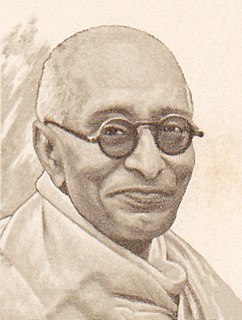
Chakravarti Rajagopalachari, popularly known as Rajaji or C.R., also known as Mootharignar Rajaji, was an Indian statesman, writer, lawyer, and independence activist. Rajagopalachari was the last Governor-General of India, as India became a republic in 1950. He was also the first Indian-born governor-general, as all previous holders of the post were British nationals. He also served as leader of the Indian National Congress, Premier of the Madras Presidency, Governor of West Bengal, Minister for Home Affairs of the Indian Union and Chief Minister of Madras state. Rajagopalachari founded the Swatantra Party and was one of the first recipients of India's highest civilian award, the Bharat Ratna. He vehemently opposed the use of nuclear weapons and was a proponent of world peace and disarmament. During his lifetime, he also acquired the nickname 'Mango of Salem'.

Paramasiva Subbarayan was an Indian politician, freedom fighter and diplomat and was the Chief Minister of Madras Presidency, India's ambassador to Indonesia and Union Minister of Transport and Communications in Jawaharlal Nehru's government. He was the father of General P. P. Kumaramangalam who served as India's Chief of Army staff and politician Mohan Kumaramangalam. He was also the grandfather of INC and BJP politician and Union Minister Rangarajan Kumaramangalam.
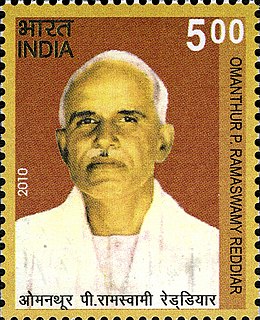
Omandur Ramasamy Reddiyar was an Indian freedom-fighter and politician of the Indian National Congress. He served as the Premier of Madras Presidency from 23 March 1947 to 6 April 1949.

Tamil Nadu Legislative Council was the upper house of the former bicameral legislature of the Indian state of Tamil Nadu. It began its existence as Madras Legislative Council, the first provincial legislature for Madras Presidency. It was initially created as an advisory body in 1861, by the British colonial government. It was established by the Indian Councils Act 1861, enacted in the British parliament in the aftermath of the Indian Rebellion of 1857. Its role and strength were later expanded by the second Council Act of 1892. Limited election was introduced in 1909. The Council became a unicameral legislative body in 1921 and eventually the upper chamber of a bicameral legislature in 1937. After India became independent in 1947, it continued to be the upper chamber of the legislature of Madras State, one of the successor states to the Madras Presidency. It was renamed as the Tamil Nadu Legislative Council when the state was renamed as Tamil Nadu in 1969. The Council was abolished by the M. G. Ramachandran administration on 1 November 1986. In 2010 the DMK regime headed by M. Karunanidhi tried to revive the Council. The former AIADMK regime (2016-2021) expressed its intention not to revive the council and passed a resolution in the Tamil Nadu Legislative Assembly in this regard.
The Modified Scheme of Elementary Education or New Scheme of Elementary Education or Madras Scheme of Elementary Education dubbed by its critics as Kula Kalvi Thittam, was an abortive attempt at education reform introduced by the Indian National Congress Government of the Madras State, led by C. Rajagopalachari (Rajaji) in 1953. The scheme proposed the introduction of two shifts or sessions in elementary schools. In one session regular teaching would be done and during the second session, the students would be sent home to learn the occupations of their parents. It became controversial and was accused of being a casteist scheme to perpetuate the caste hierarchy as Hindu Professions were caste based. Public opposition and internal dissent within the congress led to the deferment of the scheme. The discontent it triggered among the Congress legislature members forced the resignation of Rajaji as Chief Minister. The scheme was dropped completely by Rajaji's successor Kamaraj in 1954.
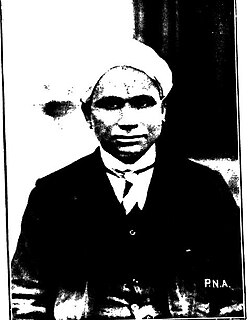
S. Muthiah MudaliarCIE was an Indian politician and legislator of the Justice Party and later, the Swarajya Party and an independent minister in the Madras Presidency. He is largely remembered for introducing the Communal Government Order implementing reservations in the Presidency.

The first legislative assembly Election to the Madras state based on universal adult suffrage was held in March 1952. This was the first election held in Madras state after the Indian Independence. This election was officially known as the 1951 Madras State Election, even though through delays, actual voting didn't take place until early 1952.

The Tamil Nadu Legislative Assembly is the unicameral legislature of the Indian state of Tamil Nadu. It has a strength of 234 members of whom are democratically elected using the First-past-the-post system. The presiding officer of the Assembly is the Speaker. The term of the Assembly is five years unless dissolved earlier.

The second legislative assembly election for the Madras Presidency after the establishment of a bicameral legislature by the Government of India Act of 1935 was held in 1946. The election was held after 6 years of Governor's rule starting from 1939, when the Indian National Congress government of C. Rajagopalachari resigned protesting Indian involvement in World War II. This was the last election held in the presidency - after Indian independence in 1947, the presidency became the Madras state. The election was held simultaneously with that of the Legislative Council. The Congress swept the polls by winning 163 out of 215 seats. The years after this election saw factionalism in Madras Congress party with divisions across regional and communal lines. Competition among T. Prakasam, C. Rajagopalachari and K. Kamaraj resulted in the election of Prakasam as the Chief Minister initially. But he was later defeated by Omandur Ramaswamy Reddiar with Kamaraj's support. In turn, Reddiar himself was ousted to make way for P. S. Kumaraswamy Raja with the support of Kamaraj.

The first legislative assembly election for the Madras Presidency was held in February 1937, as part of the nationwide provincial elections in British India. The Indian National Congress obtained a majority by winning 159 of 215 seats in the Legislative Assembly. This was the first electoral victory for the Congress in the presidency since elections were first conducted for Madras Legislative Council in 1920. The Justice Party which had ruled the presidency for most of the previous 17 years was voted out of power. The assembly was constituted in July 1937 and C. Rajagopalachari (Rajaji) became the first Congress Chief Minister of Madras.
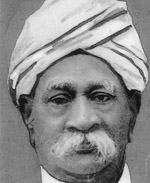
The first legislative council election to Madras Presidency after the establishment of dyarchical system of government by the Government of India Act, 1919, was held in November 1920. Indian National Congress boycotted the election due to its participation in the Non-cooperation movement. The election occurred during the early stages of non-Brahmin movement and the major issue of the election was anti-Brahminism. Justice party won the election with no significant opposition and A. Subbarayalu Reddiar became the first Chief Minister of the presidency.

The third legislative council election to Madras Presidency after the establishment of dyarchical system of government by the Government of India Act, 1919, was held in November 1926. Justice party lost the election to Swaraj Party. However, as the Swaraja Party refused to form the Government, the Governor of Madras set up an independent government under the leadership of P. Subbarayan and with the support of nominated members.
The first legislative council election for the Madras Presidency after the establishment of a bicameral legislature by the Government of India Act of 1935 was held in February 1937. The Indian National Congress obtained a majority by winning 27 out of 46 seats in the Legislative Council for which the elections were held. This was the first electoral victory for the Congress in the presidency since elections were first conducted for the Council in 1920 and C. Rajagopalachari (Rajaji) became the Chief Minister. The Justice Party which had ruled the presidency for most of the previous 17 years was voted out of power. Congress also won the Legislative assembly election held simultaneously.

The second legislative council election to Madras Presidency after the establishment of diarchical system of government by the Government of India Act, 1919 was held in 1923. Voter turnout was higher than the previous election. Swarajists, a breakaway group from Indian National Congress participated in the election. The ruling Justice Party had suffered a split, when a splinter group calling themselves anti-Ministerialists left the party. It won the highest number of seats but fell short of a majority. Nevertheless, Madras Governor Willington invited it to form the government. Incumbent Justice chief minister Panagal Raja was nominated by party leader Theagaraya Chetty to continue as chief minister for a second term. The government survived a no-confidence motion, brought against it on the first day of its tenure by the opposition headed by C. R. Reddy.
The second legislative council election for the Madras Presidency after the establishment of a bicameral legislature by the Government of India Act of 1935 was held in March 1946. The election was held after 6 years of Governor's rule starting from 1939, when the Indian National Congress government of C. Rajagopalachari resigned protesting Indian involvement in World War II. This was the last direct election held for the Madras Legislative Council in the presidency - after Indian independence in 1947, the presidency became the Madras state and direct elections to the council were abolished. The election was held simultaneously with that of the Legislative Assembly. The Congress swept the polls by winning 32 out of 46 seats. The years after this election saw factionalism in Madras Congress party with divisions across regional and communal lines. Competition among T. Prakasam, C. Rajagopalachari and K. Kamaraj resulted in the election of Prakasam as the Chief Minister initially. But he was later defeated by Omandur Ramaswamy Reddiar with Kamaraj's support. In turn, Reddiar himself was ousted to make way for P. S. Kumaraswamy Raja with the support of Kamaraj.
The Anti-Hindi imposition agitation of 1937–40 is a series of protests that happened in Madras Presidency of the British Raj during 1937-40. It was launched in 1937 in opposition to the introduction of compulsory teaching of Hindi in the schools of the presidency by the Indian National Congress government led by C. Rajagopalachari (Rajaji). This move was immediately opposed by E. V. Ramasamy (Periyar) and the opposition Justice Party. The agitation, which lasted three years, was multifaceted and involved fasts, conferences, marches, picketing and protests. The government responded with a crackdown resulting in the death of two protesters and the arrest of 1,198 persons including women and children. The mandatory Hindi education was later withdrawn by the British Governor of Madras Lord Erskine in February 1940 after the resignation of the Congress government in 1939.
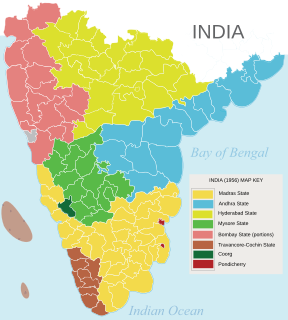
Madras State was a state of India during the mid-20th century. At the time of its formation in 1950, it included the whole of present-day Tamil Nadu, Coastal Andhra, Rayalaseema, the Malabar region of North and central Kerala, Bellary, South Canara and Kollegal. Coastal Andhra and Rayalaseema were separated to form Andhra State in 1953, while South Canara and Bellary districts alongwith the Kollegalam taluka of Coimbatore district were merged with Mysore State, and Malabar District with the State of Travancore-Cochin to form Kerala in 1956. Post State Reorganization in 1956, the remaining Madras State was renamed to Tamil Nadu, meaning "Tamil country" on January 14, 1969.
The first Legislative Assembly of Madras state was constituted in May 1952. This was following the first election held in Madras state after the Indian Independence.
Sir Cecil Fabian BrackenburyKCIE CSI was a civil servant and bureaucrat who served as Chief Secretary of the Madras Presidency from 1935 to 1939. Brackenbury was Chief Secretary when the first elections were held in the Madras Presidency as per the Government of India Act, 1935 and had a warm and friendly relationship with C. Rajagopalachari, the Premier of Madras Presidency from 1937 to 1939.
References
- ↑ Ramanathan, K. V. (2008). The Satyamurti letters: the Indian freedom struggle through the eyes of a parliamentarian, Volume 1. Pearson Education India. pp. 301–5. ISBN 978-81-317-1488-1.
- ↑ Menon, Visalakshi (2003). From movement to government: the Congress in the United Provinces, 1937–42. Sage. p. 75. ISBN 978-0-7619-9620-0.
- ↑ Nagarajan, Krishnaswami (1989). Dr. Rajah Sir Muthiah Chettiar: a biography. Annamalai University. pp. 63–70.
- ↑ The State Legislature – Origin and Evolution:Brief History Before independence Archived 13 April 2010 at the Wayback Machine
- ↑ Ilakkumi Nārāyaṇan, Ka; Gangadharan, T; Chandrasekar, N (1999). Salem city: an ethnohistory (1792–1992). Vysya College. p. 80.
- ↑ Justice Party golden jubilee souvenir, 1968. Justice Party. 1968. p. 58. ISBN.
- ↑ Verinder Grover, Ranjana Arora (1993). Great Women of Modern India: Aruna Asaf Ali. South Asia books. p. 106. ISBN 81-7100-462-8.
- 1 2 Saroja Sundararajan (1989). March to freedom in Madras Presidency, 1916–1947. Madras : Lalitha Publications. pp. 519–531.
- ↑ Bardwell L. Smith (1976). Religion and social conflict in South Asia . pp. 33. ISBN 90-04-04510-4.
- ↑ T. V. R. Shenoy (22 August 2001). "From Rajaji to Jayalalithaa". Rediff.
- ↑ I. N. Tewary (1999). Political system: a micro perspective. New Delhi: Anmol Publications PVT. LTD. p. 13.
- ↑ Eastern Economist, Annual Number. Eastern Economist. 1965. p. 1172.
- ↑ Subramaniam, Chidambaram (1993). Hand of destiny: memoirs, Volume 1. Bharatiya Vidya Bhavan. p. 166. ISBN 9788172760496.
- ↑ "Council of Ministers and their Portfolios (1952–1954)" (PDF). A Review of the Madras Legislative Assembly (1952–1957). Government of Tamil Nadu. Archived from the original (PDF) on 17 October 2013.
- ↑ Appendix Q : Modified Scheme of Elementary Education, Madras Archived 27 September 2011 at the Wayback Machine
- ↑ Appendix T : Modified Scheme of Elementary Education, Madras Archived 27 September 2011 at the Wayback Machine
- ↑ Vasantha Kandaswamy p.262-6
- ↑ The Hindu report on 19 May 1954 : Scheme dropped